by W.S. Cranshaw and Brandon Ewals-Strain* (4/20)
Quick Facts….
- Bat bugs and swallow bugs are two insects related to the bed bug.
- Bat bugs develop on bats, swallow bugs develop on cliff swallows.
- Bat bugs and swallow bugs may be found in the home if roosts or nesting areas of their wild animal hosts are present in or on a building.
- These insects may bite people on occasion but, unlike bed bugs, cannot reproduce in the absence of their wild animal hosts.
- Control of bat bugs and swallow bugs primarily requires excluding the wild animal host, bats and cliff swallows.
The bed bug (Cimex lectularius) (Fact Sheet 5.574) is a well-known insect, notorious for its ability to live and reproduce on human blood. Much less well known are several bed bug relatives that develop on birds or mammals, some of which can occur in homes and buildings in Colorado. All of these “bed bug relatives” closely resemble and are easily mistaken for the bed bug, but have different habits and are managed differently. All are in the insect family Cimicidae and are sometimes referred to as cimicids.
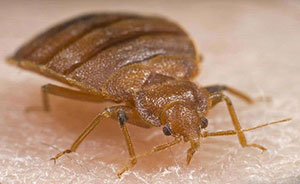
Gary Alpert, provided through Bugwood.org
Bat bugs are found in buildings that host roosting bats on which bat bugs feed. They are the most frequently encountered of the bed bug relatives and in some parts of the state are reported more often than bed bugs. Two species of bat bugs occur in the state: western bat bug (Cimex pilosellus) is found statewide; eastern bat bug (Cimex adjunctus) is much less common and restricted to areas of eastern Colorado.
Two other related insects develop on birds and can occur when their bird hosts nest on buildings or homes. Most common is the swallow bug (Oeciacus vicarius) that can be found anywhere there are nesting cliff swallows. Rarely there have been reports in Colorado homes of Hesperocimex coloradensis, associated with nests of woodpeckers and purple martins.
Identification of the Bed Bug and Relatives of Colorado
There are only minor differences in the appearance of a bed bug from other members of the insect family Cimicidae. All have an oval-round body form, all are shaded in browns or gray-brown, and all are wingless, with only small, non-functional wing pads visible on the back of the insect. Figure 1 provides a key to the features that can be used to separate the commonly encountered Colorado cimicids.
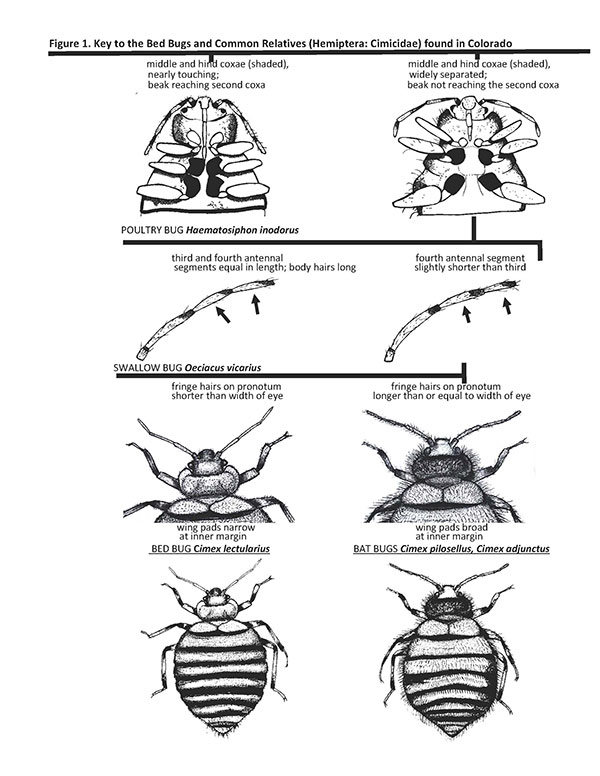
Bites
Bat and swallow bugs will bite and feed off human blood. This happens most often in spring and in late summer/early autumn, corresponding with the times when migrant hosts (cliff swallows, bats) return to Colorado and again when the hosts depart and migrate from the state. Bites are painless, but there may be a later reaction to the saliva that is introduced when feeding. There is nothing unique in the reaction one may have to the bite of a bat bug, swallow bug, or bed bug. There is wide range in individual reactions with some people showing no effects while others have a severe reaction with itching and inflammation. Human reaction to bites from these insects can be similar to that produced by mosquitoes.
Habits of the “Bed Bug Relatives”
The most important difference is the kind of animal (host) on which they can develop and reproduce. Bed bug is an insect very well adapted to living on humans and will usually be concentrated around beds and other areas where people sleep. It is the only species that can survive on a diet of human blood. The other insects (bat bugs, swallow bugs, Hesperocimex coloradensis) develop on the blood of various bat or bird hosts and occur in concentration around nesting and resting areas of these animals. These insects may bite humans but cannot successfully develop and reproduce except on the blood of their host.
The basic life stages of all these species is similar (Figure 3). Eggs are laid in cracks/crevices near where the host animal rests. Hatching from the egg is a first stage (Instar I) immature stage (nymph). It immediately seeks out a host and, if successful fully engorges on blood, a process that takes only a few minutes. The insect will then retreat to some nearby sheltered spot to digest the blood meal. The nutrients of the blood meal allow the insect to develop and it may then molt (i.e., shed the exterior “skin”) as it transforms to a slightly larger second stage nymph. The process of a nymph taking a blood meal followed by a molt to the next stage is repeated several times. An adult stage occurs with the last molt and further growth ceases. Adults closely resemble earlier stages, differing mostly in size and by their development of small wing pads on the back.
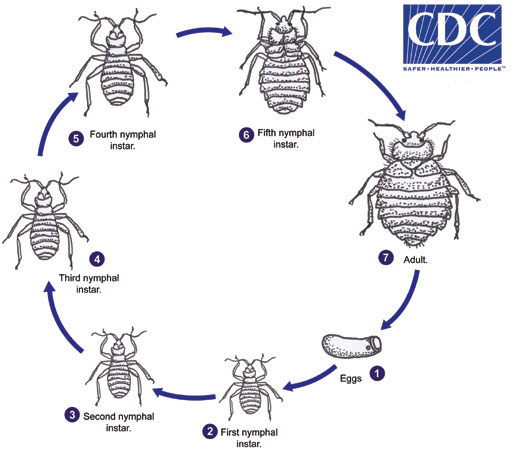
Both males and females are produced. After mating, females will begin to lay eggs. Egg laying can occur over an extended period (months) and adults will periodically take blood meals.
Bat bugs. Both of the bat bugs (eastern and western) develop as ectoparasites that feed on the blood of bats in areas where bats roost. These insects will only be found in buildings/homes that support a roosting area for bats. These are often located in the attic area but may occur between walls or under loose siding, outside buildings, in chimneys, and under shingles. When bats are present, bat bugs will usually move off of the bat after feeding to settle nearby and digest the blood meal. Some bat bugs may settle on the resting bat, within the folded wings, and bat bugs can be carried to new roosting areas in this manner.
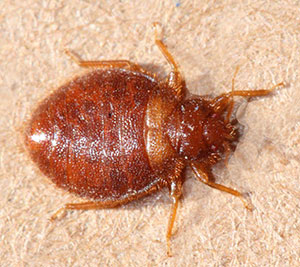
The activity of bat bugs in a building follows that of their bat hosts. Little brown bat (Myotis lucifugus) and big brown bat (Eptesicus fuscus) are the most common colonial bats found roosting in buildings/homes in Colorado. Both of these are normally migratory species that leave in fall (typically September) to head for areas in southern California or Mexico where winter is spent. The bats return to Colorado at the very end of April to the beginning of May.
When these bats migrate, most of the bat bugs stay behind in the area where the bats had roosted. However, some bat bugs may move about once their hosts have vacated and wander into living areas. Bat bugs are usually found in upper stories of buildings, nearest to areas of a bat roost, but they may travel considerable distances following chimneys and channels behind walls and have been found in basements. Bat bug activity within living areas of homes occurs most commonly during the late summer and fall when their population is highest and once the bats migrate leaving many insects looking for an alternative blood meal. Bat bug movements into living areas of a building can also be triggered at any time when roosting bats are excluded from the building or die.
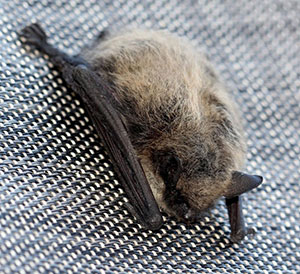
Bat bugs, at least the adult stages, are highly resistant to starvation and normally suspend feeding for a long period (7-8 months) when their bat hosts are not present. With the return of the bats, bat bugs resume reproduction and development. As bat bugs stir from dormancy with the return of bats in spring, there may be another peak period when bat bugs are detected inside the home or business.
Bats are the only host animal on which bat bugs can develop and reproduce. In the extended absence of bats, such as when they are excluded from a building, bat bugs will eventually die off.
Note on proper diagnosis of bat bugs vs. bed bugs. Because of their close similarity in appearance it is quite common to misidentify a bat bug infestation. In some rare cases, homes may have a mixture of both bat bugs and bed bugs inside the same structure.
Most bed bug activity is located near an area where a person rests – beds, chairs, sofas. In addition, you will find bed bugs nearby (within a few feet) if there is adequate hiding (harborage) locations like behind a picture frame or nightstand.
The location of bat bug activity is much different. Bat bugs are most commonly found on the upper floor, where they are closest to the bat roost. Typically, one will find a single individuals at a time, rather than aggregations such as bed bugs can produce in the living area of the building. Occasionally you will find bat bugs in the basement of older homes if the bats are getting inside the chimney. Generally speaking bat bugs will come down from either the attic or chimney via cracks around light fixtures, attic hatches, edges around vents, window cracks, through the chimney, or along open holes in drywall.
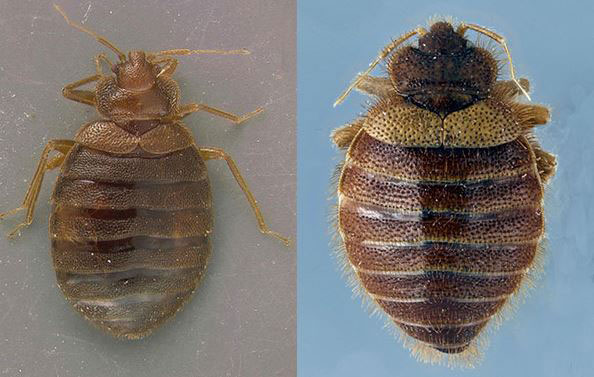
Swallow bugs. Swallow bugs develop as an ectoparasite of swallows, particularly cliff swallows (Petrochelidon pyrrhonota). These birds build their jug-shaped mud nests under overhangs of cliffs or attached to various man-made structures that provide shelter, such as bridges, culverts, and under eaves of buildings. Problems with swallow bugs in buildings occur when cliff swallows are allowed to nest on human-inhabited structures.
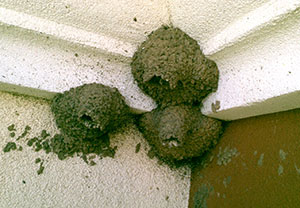
Cliff swallows are a migratory bird, typically arriving in Colorado during late April. Nests of previous years may be reused and swallow bugs that survive through winter at the site will move to the nesting birds soon after their return. Very large numbers of swallow bugs may then develop during spring and summer, with some nests harboring hundreds or even thousands of these insects. When the swallows leave in late summer, usually by mid-September, the swallow bugs move to protected cracks and crevices where they will live, without feeding, through the seven months or so when their bird hosts are absent.
Swallow bugs will readily bite humans. As with bed bugs, there are two periods of the year when bites will peak. One is in spring, shortly before migrant swallows return to nest on the building and the overwintered swallow bugs resume activity. Most survivors are adults and they are highly starved at this time, so they may aggressively seek alternate sources of a blood meal. Problems subside when the swallows are present and the swallow bugs migrate to the nest area. Swallow bugs will again be found more commonly within homes, and biting may occur, when the swallows abandon the nest. A greater mixture of life stages may be present in buildings in autumn than in spring, as immature bugs (nymphs) poorly survive the extended period of starvation that follows.
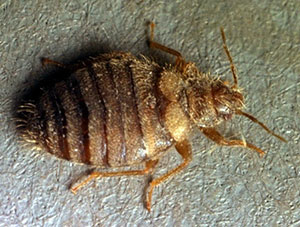
Cliff swallows are the only host animal on which swallow bugs can develop and reproduce. As with bat bugs, in the extended absence of their host, swallow bugs will die out by starvation.
Swallow bugs can be serious pests of cliff swallows. In some studies, cliff swallows only return to nesting locations every other year to avoid high populations of swallow bugs. In spring the returning birds will investigate the mouths of the mud nests to detect the presence of swallow bugs before choosing to nest in an old mud nest or choose to build a new one.
Hesperocimex coloradensis. Hesperocimex coloradensis can be found in homes when some type of cavity nest has been constructed on the side of a building, usually by a woodpecker or flicker. When the nest is occupied by a type of bird that can host H. coloradensis, usually woodpeckers or purple martins, the insect may later wander into living areas when the nests are abandoned.
This insect is only rarely reported in homes in Colorado. There are no reports establishing whether it will bite humans.
Management of Bat Bugs and Bird-feeding Bugs
Exclusion of animal hosts. Problems with bat bugs and bird-feeding bugs in homes occur when the animal host (bats, swallows, purple martins) are nesting or roosting on or within the building. If these wild animal hosts are excluded from the building, these insects will ultimately die out from starvation and new infestations can be prevented. Exclusion efforts should take place during the time of year when the animals are absent – October through early April.
A lot of bat colonies that occur in buildings are nursery colonies with developing young. As bats are very beneficial animals that can provide enormous benefits in insect control, active bat colonies should never be disturbed unless there is some immediate health risk. The best approach is to first identify where they roost, and where the entry points are located. After the bats leave in the fall the entry points can be blocked or screened to prevent roosting the following spring when bats return.
Most bats do migrate annually and exclusion of the entry points during winter, by screening or use of other barriers, will achieve the goal of keeping the bats from returning the following spring. In cases where bats choose to hibernate instead of migrating, efforts should be made to use one-way doors early in spring to evict the bats before they have young in early summer. There are also safety issues involved with bat removal; bats may carry rabies, a very serious disease that can be transmitted by the bite of an infected bats. Bats are also protected species under Federal law. Professional help will be needed to safely protect both humans and developing bats during the exclusion process.
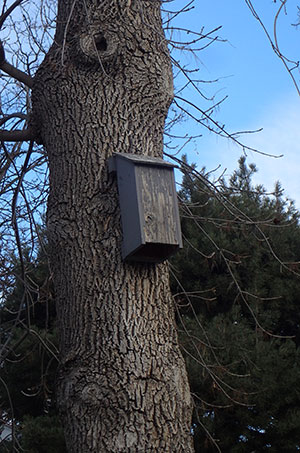
Note on bat houses. The use of bat houses that provide a roosting area for bats can help conserve and assist bat populations. If these are used there should be care in their placement as bat bugs may colonize the bat house and some may later move into the building/home. It is suggested that bat houses be placed on non-occupied structures. If placed on an occupied building they should be located on an area distant from where people sleep and all cracks/crevices in the vicinity of the building of the bat house should be well caulked/sealed before the bat house is placed on the building.
Most all birds, including cliff swallows are a protected species under the Migratory Bird Act and it is illegal to disturb active nests with eggs or young. Old nests attached to buildings can be taken down after birds have migrated. This must be done carefully since swallow bugs remaining with the old nest can crawl rapidly onto hair and clothing and will bite.
Nests that are being newly constructed in spring can be destroyed before they are complete and nesting occurs. Screening and other exclusions may also be used to deter future nesting.
Problems with Hesperocimex coloradensis in homes can be eliminated by screening or covering cavities in the sides of buildings where their bird hosts nests. These birds (purple martins, flickers, woodpeckers) are similarly protected by federal law and exclusion must be done in a manner that does not disturb active nests.
Exclusion of bat and swallow bugs from living areas. Once the animal host (bats, birds) has been excluded, there will be no further increase in the number of bugs present in the building. However, the insects that developed earlier will remain and these may continue to wander about in search of a blood meal for several months before they ultimately starve to death. Under laboratory conditions a few adult insects have been known to survive for over a year without a blood meal.
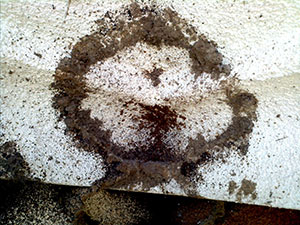
and may find ways to enter interior areas of the building. Photograph by Brandon Ewals-Strain.
Migrations can be deterred by blocking access points the insect use into the living areas. Areas behind walls provide corridors for insect travel, but some opening is needed for their entry into living areas. These may be cracks around windows, gaps around electrical sockets, or other holes/cracks in walls. All of these should be sealed or caulked.
Insecticides can be useful in speeding the elimination of bat bugs and swallow bugs present in a building. These are applied as dusts or sprays, injected into cracks and crevices where bat bugs and swallow bugs enter. To be effective, the insecticide must have some residual effectiveness so that they can kill insects over an extended period. Dust formulations (usually containing deltamethrin) can be particularly effective way to treat areas behind walls and cavities where bats may roost. These are injected into voids (roosts or nests) with a bulb or bellow duster and the dust persists well on surfaces it reaches. Professional assistance is recommended to effectively make these applications. A respirator should always be worn whenever applying dust formulations as they are more easily inhaled than are applications applied as sprays.
Another type of dust that may be useful when injected into cracks and areas behind walls are desiccant dusts, products that damage the surface of the insect body and cause them to lose water. Particularly effective is silica aerogel, which is highly absorbent of the wax that covers the body and protects insects from water loss. Silica aerogel is an extremely fine dust and requires care in its safe and effective application. A respirator is absolutely necessary protection for an applicator when using silica aerogel and to be effective a very fine coating of surfaces is needed.
Insecticide sprays may also be useful if carefully injected into cracks/crevices in areas travelled or used for shelter by bat/swallow bugs as they move through the home. Some retail products may be used. These are usually “ready-to-use” formulations with the active ingredient the insecticides bifenthrin, cyfluthrin, or lambda-cyhalothrin. Professional applicators have access and ability to use other products (e.g., Temprid, a cyfluthrin/imidacloprid combination) that can be more effective.
There are numerous products household insecticides marketed with claims to “kill” insects, including bed bugs; many of these have little, or no, value to manage bat/swallow/bed bugs. Products such as insecticidal soaps, pyrethrins, and various essential oil products (e.g., rosemary oil, garlic oil) can likely kill a bat bug or swallow bug – if it is applied directly to the insect. However, they have no residual activity and will not kill any insects that cannot be reached at the moment of application, making these effectively useless. A particularly poor product for this situation are “bug bombs” that make an aerosol release of an insecticide (e.g., pyrethrins, permethrin). These not only have poor ability to kill bed/bat/swallow bugs, but usually have the effect of driving survivors more deeply into the inaccessible areas of the structure, such as behind walls, and may cause them to scatter through the building, making control more difficult.
All insecticides must only be used in accordance with label use instructions. Before using any insecticide, indoors or outdoors, it is important to read the label and make applications only in a manner that the pesticide label allows.
*Whitney Cranshaw, Professor/Extension Specialist Colorado State University; Brandon Ewals-Strain, Owner/Operator, Northern Colorado Pest and Wildlife Control. 4/20.





